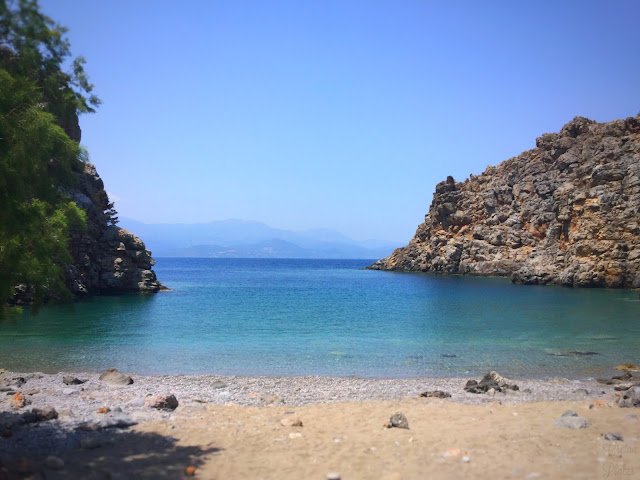Due to geology, Crete has a remarkable number of inlets extremely beautiful as swimming places.
The showcased beach is a not widely known place to the NW of Kavousi (Lassithi area). From the spot of an old lime kiln near the parking area, follow the trail (being assured that you close the couple of doors for the fences) for about ten minutes leading downhill into a narrow ravine to the small inlet, with the place name Agriomandra (or Ayiomandra). This cove served as a prominent port for the area from the Roman era to the middle of the 20th century receiving local products (carobs, olive oil, cheese etc.), so a cobbled path (kalderimi), dated to the Venetian or Ottoman period linked the port with the interior (Betancourt 2006). The beach has rock outcrops on both sides and is really scenic! At the NE end of this small cove a small islet is formed, having the same place name: Agriomandra.
The showcased beach is a not widely known place to the NW of Kavousi (Lassithi area). From the spot of an old lime kiln near the parking area, follow the trail (being assured that you close the couple of doors for the fences) for about ten minutes leading downhill into a narrow ravine to the small inlet, with the place name Agriomandra (or Ayiomandra). This cove served as a prominent port for the area from the Roman era to the middle of the 20th century receiving local products (carobs, olive oil, cheese etc.), so a cobbled path (kalderimi), dated to the Venetian or Ottoman period linked the port with the interior (Betancourt 2006). The beach has rock outcrops on both sides and is really scenic! At the NE end of this small cove a small islet is formed, having the same place name: Agriomandra.
After the abandonment of the harbor, this cobbled path went out of use, although is still standing in many parts in the SW bank of the gorge. On the way down the route, the new path is diverting to the NE bank where the cave church of Agios Ioannis is located (giving the alternative place name Ayiomandra). We hope that the old kalderimi will be preserved, needing conservation works ASAP.
⇑ Pros: without doubt Agriomandra is a hidden gem: scenic place, view, serenity, beautiful sandy beach. Given that the inlet was preferred as a roadstead, the sea is usually calm.
⇓ Cons: moderate signaling, bad condition of the road network approaching the parking area and no maintenance of the path leading from the parking to the beach.
⇨ Where to go / what to do: This beach is ideal for swimming! Moreover, in the SW end of the beach there is a cooking and resting place under a tamarix. You can also visit Chrysokamino archaeological site, about a kilometer to the SE. Be aware: keep this place clean!
 |
| In the SW end of the beach there is a cooking and resting place under a tamarix. |
🔝 Best time to visit: April - June and September - October if you prefer privacy.
 |
| Map of the area, combining background layer by Google Earth and topographic layer by Betancourt (2006). |
Agriomadra beach is ranked by the CretanPlaces project as one of the top-5 beaches in Crete for windy days, read about the top 4 + 1 sheltered beaches in Crete.
For directions and more info, feel free to ask: cretanplaces@gmail.com
Bibliography: Betancourt, Ph. (2006). The Chrysokamino metallurgy workshop and its territory. Hesperia Supplement 36. Princeton: The American School of Classical Studies at Athens.
🔃 What do you think about this place? Feel free to leave a comment!



Comments
Post a Comment